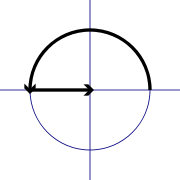
Euler's identity
About this schools Wikipedia selection
This Schools selection was originally chosen by SOS Children for schools in the developing world without internet access. It is available as a intranet download. All children available for child sponsorship from SOS Children are looked after in a family home by the charity. Read more...

In mathematical analysis, Euler's identity, named after Leonhard Euler, is the equation
where
 is Euler's number, the base of the natural logarithm,
is Euler's number, the base of the natural logarithm, is the imaginary unit, one of the two complex numbers whose square is negative one (the other is
is the imaginary unit, one of the two complex numbers whose square is negative one (the other is  ), and
), and is pi, the ratio of the circumference of a circle to its diameter.
is pi, the ratio of the circumference of a circle to its diameter.
Euler's identity is also sometimes called Euler's equation.
Nature of the identity
Euler's identity is considered by many to be remarkable for its mathematical beauty. Three basic arithmetic operations occur exactly once each: addition, multiplication, and exponentiation. The identity also links five fundamental mathematical constants:
- The number 0.
- The number 1.
- The number π, which is ubiquitous in trigonometry, geometry of Euclidean space, and mathematical analysis.
- The number e, the base of natural logarithms, which occurs widely in mathematical analysis (e ≈ 2.71828).
- The number i, imaginary unit of the complex numbers, which contain the roots of all nonconstant polynomials and lead to deeper insight into many operators, such as integration.
Furthermore, in mathematical analysis, equations are commonly written with zero on one side.
Perceptions of the identity
A reader poll conducted by Mathematical Intelligencer named the identity as the most beautiful theorem in mathematics. Another reader poll conducted by Physics World in 2004 named Euler's identity the "greatest equation ever", together with Maxwell's equations.
The book Dr. Euler's Fabulous Formula [2006], by Paul Nahin (Professor Emeritus at the University of New Hampshire), is devoted to Euler's identity; it is 400 pages long. The book states that the identity sets "the gold standard for mathematical beauty."
Constance Reid claimed that Euler's identity was "the most famous formula in all mathematics."
Gauss is reported to have commented that if this formula was not immediately apparent to a student on being told it, the student would never be a first-class mathematician.
After proving the identity in a lecture, Benjamin Peirce, a noted nineteenth century mathematician and Harvard professor, said, "It is absolutely paradoxical; we cannot understand it, and we don't know what it means, but we have proved it, and therefore we know it must be the truth."
Stanford mathematics professor Keith Devlin says, "Like a Shakespearean sonnet that captures the very essence of love, or a painting that brings out the beauty of the human form that is far more than just skin deep, Euler's equation reaches down into the very depths of existence."
Derivation
The identity is a special case of Euler's formula from complex analysis, which states that
for any real number x. (Note that the arguments to the trigonometric functions sin and cos are taken to be in radians.) In particular, if
then
Since
and
it follows that
which gives the identity
Generalization
Euler's identity is a special case of the more general identity that the nth roots of unity, for n > 1, add up to 0:
Euler's identity is the case where n = 2.
Attribution
While Euler wrote about his formula relating e to cos and sin terms, there is no known record of Euler actually stating or deriving the simplified identity equation itself; moreover, the formula was likely known before Euler. Thus, the question of whether or not the identity should be attributed to Euler is unanswered.










